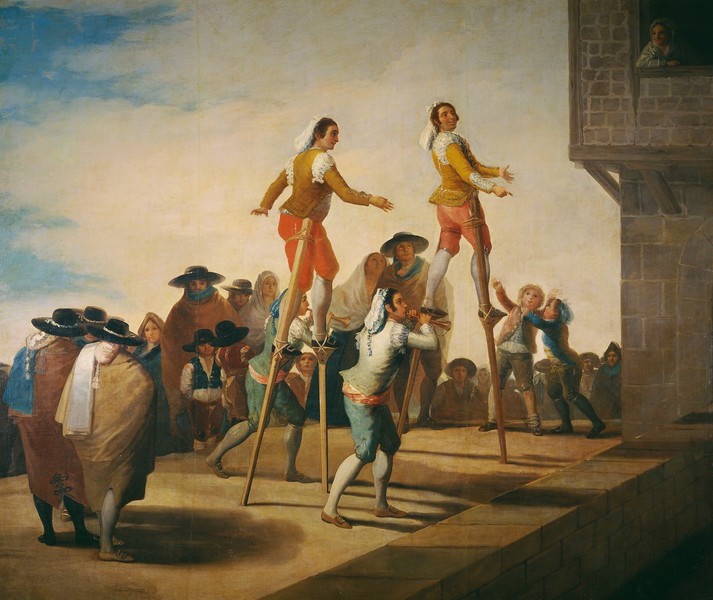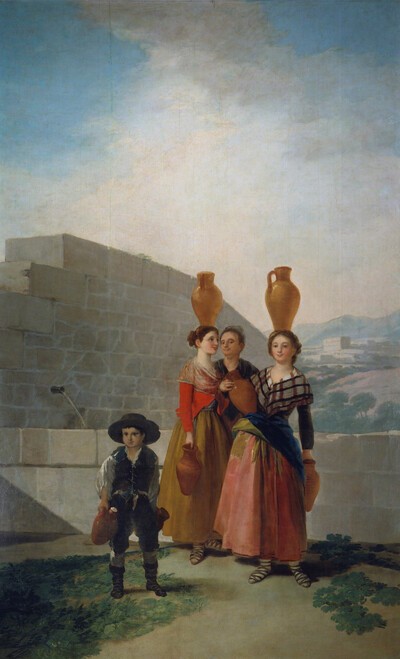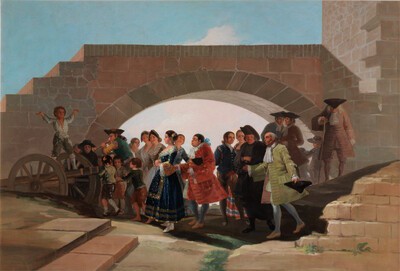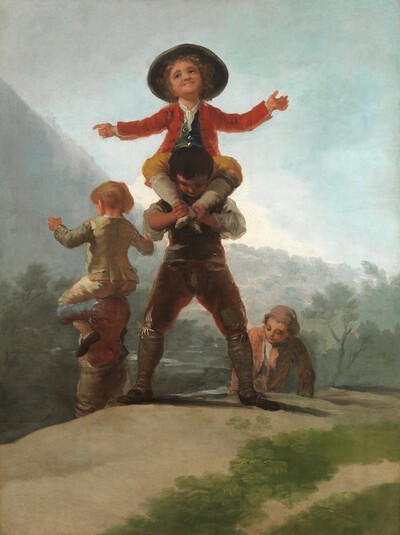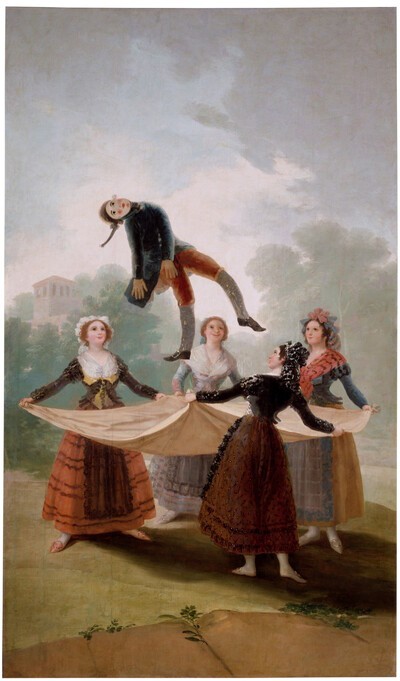- Cronología
- 1791 - 1792
- Ubicación
- The Prado National Museum. Madrid, Madrid, Spain
- Dimensiones
- 268 x 320 cm
- Técnica y soporte
- Oil on canvas
- Reconocimiento de la autoría de Goya
- Documented work
- Titular
- El Prado National Museum
- Ficha: realización/revisión
- 27 Dec 2009 / 14 Jun 2023
- Inventario
- (P00801)
See The Wedding.
In a rural setting, this scene depicts two men walking on stilts, accompanied by two flautists and being watched by the townspeople. This is often considered to be a simple representation of a feast day. In fact, Cruzada Villaamil believed that this was the only cartoon in which Goya represented a tradition from his native Aragón.
But more complex readings have also been made, such as that put forward by Victor Chan, in which the stilts would represent good luck and the woman looking out of the window on the right-hand side of the composition would be Fortuna, whilst the melancholy-faced spectators would be reflecting upon the changing nature of fortune and fate. Janis Tomlinson believes that the Spanish expression "subirse a los zancos", meaning to walk on stilts, suggests that someone has a haughty, arrogant character. She also points out that those watching the show are an anonymous crowd, implying the distance that the artist has put between himself and them. This could be related to a piece of writing by Jovellanos, published in 1790, which makes reference to spectacles of this kind. The politician was against these forms of entertainment because they only permitted those in attendance to enjoy the show passively. Jovellanos' efforts to discourage the people to shun such spectacles in favour of a more active form of entertainment perhaps led Goya to "subirse a los zancos" and create in his painting a public which appears as a mass of anonymous, homogeneous spectators. The same type of crowd can be found in other works by Goya, both from the same period and later on.
-
El arte de GoyaMuseo de Arte Occidental de TokioTokyo1971from 16th 1971 to January 23th 1972. Exhibited also at the Kyoto Municipal Museum of Art, January 29th to March 15th 1972.cat. 14
-
Goya. 250 AniversarioMuseo Nacional del PradoMadrid1996consultant editor Juan J. Luna. From March 29th to June 2nd 1996cat. 55
-
Goya en Madrid. Cartones para tapices 1775-1794Museo Nacional del PradoMadrid2014p. 193
-
L'œuvre peint de Goya. 4 volsParís1928-1950vol. I, p. 100, cat. 41
-
Tapices de GoyaMadridPatrimonio Nacional1946pp. 170-171, 276, cat. 60 y lám. 189
-
Vie et ouvre de Francisco de GoyaParísOffice du livre1970p. 99, cat. 303
-
BarcelonaPolígrafa1970vol. I, p. 283, cat. 303
-
L’opera pittorica completa di GoyaMilanRizzoli1974p. 105, cat. 259
-
Francisco de Goya, 4 vols.ZaragozaCaja de Ahorros de Zaragoza, Aragón y Rioja1980-1982vol. II, p. 90 y p. 49 (il.)
-
Goya’s tapestry cartoon of the straw manikin: a life of games and a game of lifeArts Magazine1985p. 52
-
Francisco de Goya, cartones y tapicescol. col. "Espasa Arte"Espasa Calpe1987pp. 169, 317, cat. 65C; p. 169 (il.) y l
-
Francisco de Goya. Los cartones para tapices y los comienzos de su carrera en la corte de Madridcol. col. "Ensayos de Arte Cátedra"MadridCátedra1987pp. 255-258 y p. 254 (il.)
-
Goya. Catálogo de la pinturaZaragozaReal Academia de Nobles y Bellas Artes de San Luis1994p. 220, cat. 210
-
Goya. 250 AniversarioMadridMuseo del Prado1996p. 337, cat. 55 y pp. 140, 141 (ils.)
-
Goya en Madrid. Cartones para tapices 1775-1794MadridMuseo Nacional del Prado2014p. 193
